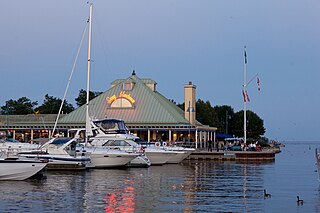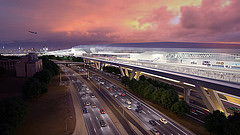Community Air is a non-profit resident association in the city of Toronto, Ontario, Canada that seeks to have the Toronto Island Airport shut down and its lands converted to park land. The association is concerned about noise, pollution and safety aspects of the airport's operation. The group has regularly held protests at the airport site and at the airport's operator's (the Toronto Port Authority) general meetings.
Opposition to the island airport goes back to the 1930s, when a plan to build a tunnel to the islands for a new airport was shut down after a federal election. The Toronto mayor at the time was a Toronto Islands resident and opponent of the project. After his death, Toronto City Council revived the airport project, without the tunnel, to be Toronto's main airport. This airport has remained in use since 1939, serving mainly general aviation. An airport at Malton, Ontario instead became Toronto's main airport and is today's Pearson Airport.
A plan was raised in the 1970s to add scheduled passenger service at the island airport by federal politicians. At the time, Toronto was a two-tier government. The City of Toronto was part of Metropolitan Toronto. Local opposition appeared to the plan to add planes to the airport. The City of Toronto opposed the plan, while Metro Toronto voted in favour. A compromise was reached in 1983 allowing only STOL type planes to use the airport with jets banned, and no runway expansion allowed.
In the 1990s, plans were revived to expand the airport, and Toronto City Council, now an amalgamated city government voted in favour of building a bridge, although the plan never progressed beyond a plan on paper. However in 1999, the Toronto Port Authority was formed, a new agency tasked with managing the airport and Toronto harbour. The agency took on a pro-airport expansion position and started pushing the airport expansion idea publicly. The agency expressed the opinion, backed by a 2001 consultant's study, that the airport could not survive as is, and had to expand or shut down. The TPA proposed the expansion of the airport for its economic benefit to the city.
Also during the 1990s, the city had taken an interest in waterfront revitalization, with several studies proposing the takeover of harbour and airport functions and the conversion of disused or under-used port lands for other uses. The consensus of revitalization studies was the removal of the Gardiner Expressway in the downtown area, greening of the lakefront and harbourfront, and a closure or reduction in the island airport.
Opposition to the island airport was formalized into the Community AIR (Airport Impact Review) volunteer association in 2001, headed by activist and former councillor Allan Sparrow. It was formed by local residents to oppose expansion on the grounds of increased air and noise pollution, safety concerns and that the increase in air traffic will hamper recent government initiatives to rejuvenate the Toronto waterfront. [1] In July 2001, at a news conference held with representatives of the Sierra Club, the David Suzuki Foundation and the Toronto Environmental Alliance, the group proposed converting the 200 acres (81 ha) airport to parkland. [2] Community Air's aims were and are supported by the City councillors of the area, including Adam Vaughan.
Even with the Community Air's support of the cancellation of the fixed-bridge to the Island Airport (as a result of the election of David Miller as mayor), the issue of a link to the mainland continued to be discussed.
In July 2010, a new proposal for a tunnel to the island was raised by the Toronto Port Authority. The revised designs for the tunnel specifically circumvented any need for local council approval. Community Air was not able to block the construction which began in the Summer of 2012. The tunnel replaced what critics called the shortest ferry crossing between the mainland and the island.
In 2006 the Toronto Port Authority launched a lawsuit against Community Air, claiming it had defamed individual board members and the agency.
On May 2, 2007, the lawsuit was dropped after Community Air issued an unconditional apology. [3]
Critics of Community Air point out that the far distance of Toronto Pearson International from the downtown core makes it inconvenient for passengers in the latter, therefore the much shorter commute time to the Island Airport for those passengers would actually save time and pollution. The high-speed rail link between downtown and Pearson International, which then-mayor David Miller proposed as an alternative to expanding the Island Airport, itself took years to materialize since it faced opposition from residents along that route.
Critics note that Community Air has not targeted the increasing air traffic at suburban Toronto Pearson, with its proximity to lower-income communities such as Rexdale and Malton. In addition, Community Air has not criticized Pearson's expensive user and landing fees, which were raised substantially in 2003 with the opening of Pearson's Terminal 1-New, with the Greater Toronto Airport Authority expanding its monopoly over air travel in the Greater Toronto Area (as Hamilton International Airport was no longer viable as a reliever airport).
Porter's aircraft (Bombardier Q400s) are one of the quietest models to date (the Q standing for 'quiet') and critics claim the noise pollution incidents have not been as loud as what Community AIR claimed. The unions and airline industry suppliers have criticized Community Air for potentially hurting jobs.
Critics of Community Air have pointed out that the Gardiner Expressway, situated on the city's shoreline, contributes over 48,000 times more pollution than does the Island airport (Source: Report on Toronto's Waterfront).

The Port Authority of New York and New Jersey, is a joint venture between the U.S. states of New York and New Jersey, established in 1921 through an interstate compact authorized by the United States Congress. The Port Authority oversees much of the regional transportation infrastructure, including bridges, tunnels, airports, and seaports, within the geographical jurisdiction of the Port of New York and New Jersey. This 1,500-square-mile (3,900 km2) port district is generally encompassed within a 25-mile (40 km) radius of the Statue of Liberty National Monument. The Port Authority is headquartered at 4 World Trade Center.

Mississauga, historically known as Toronto Township, is a Canadian city in the province of Ontario, situated on the western shore of Lake Ontario in the Regional Municipality of Peel, adjoining the western border of Toronto. With a population of 717,961 as of 2021, Mississauga is the seventh-most populous municipality in Canada, third-most in Ontario, and second-most in the Greater Toronto Area (GTA) after Toronto itself. However, for the first time in its history, the city's population declined according to the 2021 census, from a 2016 population of 721,599 to 717,961, a 0.5 percent decrease.

NIMBY, an acronym for the phrase "not in my back yard", is a characterization of opposition by residents to proposed developments in their local area, as well as support for strict land use regulations. It carries the connotation that such residents are only opposing the development because it is close to them and that they would tolerate or support it if it were built farther away. The residents are often called nimbys, and their viewpoint is called nimbyism. The opposite movement is known as YIMBY for "yes in my back yard".

Billy Bishop Toronto City Airport is a regional airport located on the Toronto Islands in Toronto, Ontario, Canada. It is often referred to as Toronto Island Airport and was previously known as Port George VI Island Airport and Toronto City Centre Airport. The airport's name honours Billy Bishop, the Canadian World War I flying ace and World War II Air Marshal. It is used by civil aviation, air ambulances, and regional airlines using turboprop planes. In 2022, it was ranked Canada's ninth-busiest airport.

Harbourfront is a neighbourhood on the northern shore of Lake Ontario within the downtown core of the city of Toronto, Ontario, Canada. Part of the Toronto waterfront, Harbourfront extends from Bathurst Street in the west, along Queens Quay, with its ill-defined eastern boundary being either Yonge Street or York Street. Its northern boundary is the Gardiner Expressway. Much of the district was former water lots filled in during the early 1900s to create a larger harbour district. After shipping patterns changed and the use of the Toronto harbour declined, the area was converted from industrial uses to a mixed-use district that is mostly residential and leisure.

The Toronto waterfront is the lakeshore of Lake Ontario in the city of Toronto, Ontario, Canada. It spans 46 kilometres between the mouth of Etobicoke Creek in the west and the Rouge River in the east.

Tweed-New Haven Regional Airport is a public airport located three miles southeast of downtown New Haven, in New Haven County, Connecticut, United States. The airport is partly located in the City of New Haven, which owns the airport, and partly in the town of East Haven.

The Pickering Airport Lands are parcels of lands owned by the Government of Canada located in York Region and Durham Region in the Canadian province of Ontario. The lands, totaling approximately 18,600 acres and located approximately 56 kilometres east of Downtown Toronto, were expropriated in 1972 by the federal government intending to build a second international airport to serve the city of Toronto, its metropolitan area, and the surrounding Golden Horseshoe region. Since then, the federal government has leased the lands to private tenants and allocated more than half to form the Rouge National Urban Park.

The cancelled expressways in Toronto were a planned series of expressways in Toronto, Ontario, Canada that were only partially built or cancelled due to public opposition. The system of expressways was intended to spur or handle growth in the suburbs of Toronto, but were opposed by citizens within the city of Toronto proper, citing the demolition of homes and park lands, air pollution, noise and the high cost of construction. The Spadina Expressway, planned since the 1940s, was cancelled in 1971 after being only partially constructed. After the Spadina cancellation, other expressway plans, intended to create a 'ring' around the central core, were abandoned.

The Toronto Port Authority (TPA), doing business as PortsToronto (PT), is a port authority that is responsible for the management of the Port of Toronto, including the International Marine Passenger Terminal, and Billy Bishop Toronto City Airport. It was established under the Canada Marine Act as a government business enterprise that is self-funded, with directors appointed by three levels of government – the Government of Canada, the Government of Ontario and the City of Toronto. The TPA rebranded itself as PortsToronto in 2015.

The Union Pearson Express is an airport rail link connecting Union Station in Downtown Toronto to Toronto Pearson International Airport. The UP Express began operation on 6 June 2015, in time for the 2015 Pan American Games. The UP Express travels between Union and Pearson in 25 minutes departing every 15 minutes, seven days a week. At the launch announcement, it was stated that the UP Express was projected to carry 2.35 million passengers annually and eliminate approximately 1.2 million car trips in the first year. As of 2019, it carried 4.5 million passengers annually.

Lester B. Pearson International Airport, commonly known as Toronto Pearson International Airport, or simply Toronto Pearson or Pearson, is an international airport located in Mississauga, Ontario, Canada. It is the main airport serving Toronto, its metropolitan area, and the surrounding region known as the Golden Horseshoe. The airport is named in honour of Lester B. Pearson, who served as the 14th Prime minister of Canada and received the Nobel Peace Prize in 1957 for his humanitarian work in peacekeeping.

Porter Airlines is a Canadian airline headquartered at Billy Bishop Toronto City Airport on the Toronto Islands in Toronto, Ontario, Canada. Owned by Porter Aviation Holdings, formerly known as REGCO Holdings Inc., Porter operates regularly scheduled flights between Toronto and locations in Canada and the United States using a fleet of Canadian-built De Havilland Canada DHC-8-400 turboprop aircraft and Embraer E195-E2 jet aircraft.
Transportation in the Canadian city of Toronto forms the hub of the road, rail and air networks in the Greater Toronto Area and much of southern Ontario. There are many forms of transport in the city, including railways, highways, and public transit. Toronto also has an extensive network of bicycle lanes and multi-use trails and paths.

The Toronto Harbour Commission (THC) was a joint federal-municipal government agency based in Toronto, Ontario, Canada. The agency managed Toronto Harbour as well as being responsible for major works along the Toronto waterfront. It built both Malton Airport and the Toronto Island Airport in 1939. The agency was founded in 1911 and operated until 1999 when the port operations were transferred to the new Toronto Port Authority (TPA), now PortsToronto.

Originally conceived in the 1930s as the main airport for Toronto, the Toronto island airport has long been a source for political debate as to the proper use of its waterfront site in central Toronto. Building the airport necessitated the closure of park lands, a hotel, cottages and an amusement park on the Toronto Island site. Construction of the airport in the late 1930s was stopped and started and its final construction only went ahead after the death of the Toronto mayor who had opposed its construction.

AirTrain LaGuardia was a proposed 1.5-mile-long (2.4 km) people mover system and elevated railway in New York City, United States, that would provide service to LaGuardia Airport in Queens. It would have connected with the New York City Subway and Long Island Rail Road (LIRR) in Willets Point, similar to how the existing AirTrain JFK system connects John F. Kennedy International Airport’s six terminals to the LIRR in southern Queens at Jamaica station and to the subway at both Sutphin Boulevard–Archer Avenue–JFK Airport station and Howard Beach-JFK Airport station; and how the existing AirTrain Newark station connects Newark Liberty International Airport’s three terminals to NJ Transit Rail Operations and Amtrak at a dedicated station.
In its early years, what is now Toronto Pearson International Airport was known as the Malton Airport. Established in 1937, it was built by the Toronto Harbour Commission and was originally intended to serve as an alternate airfield to the downtown Toronto Island Airport. Pearson instead became the primary airport for the Greater Toronto Area and the entire Golden Horseshoe region. Today, Toronto Pearson is the largest and busiest airport in Canada and is among the busiest airports in the world.

The transport infrastructure and services in the Canadian city of Mississauga, Ontario include provincial highways and municipal roads, passenger and freight rail, regional and municipal bus service, and an international airport. It is interconnected with air, road, and rail transportation networks spanning the Greater Toronto Area and beyond.

Piers Park is a public park owned by Massport located on the southwest side of East Boston, overlooking Boston Harbor and downtown Boston. Designed by Pressley Associates Landscape Architects of Boston, the 6.5-acre (2.6 ha) park was conceived to reclaim a condemned industrial pier for recreational use, allowing residents and visitors direct access to the waterfront.
{{cite news}}: Missing or empty |title= (help)